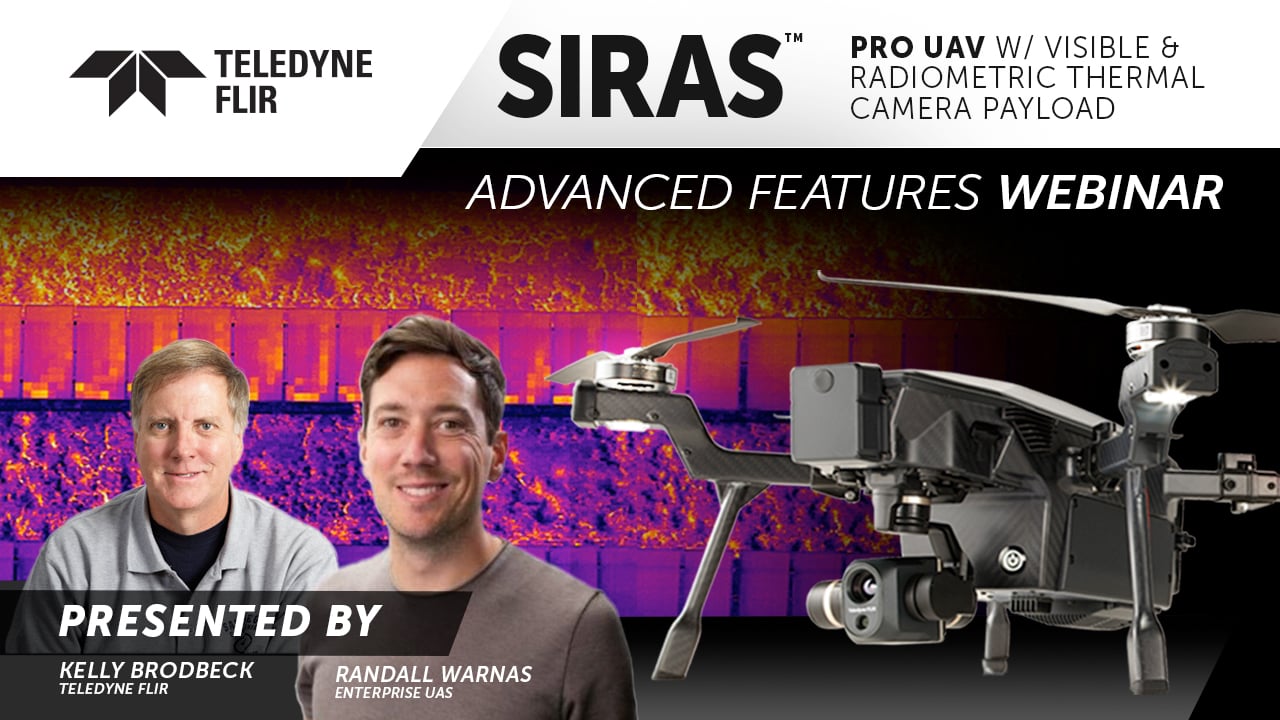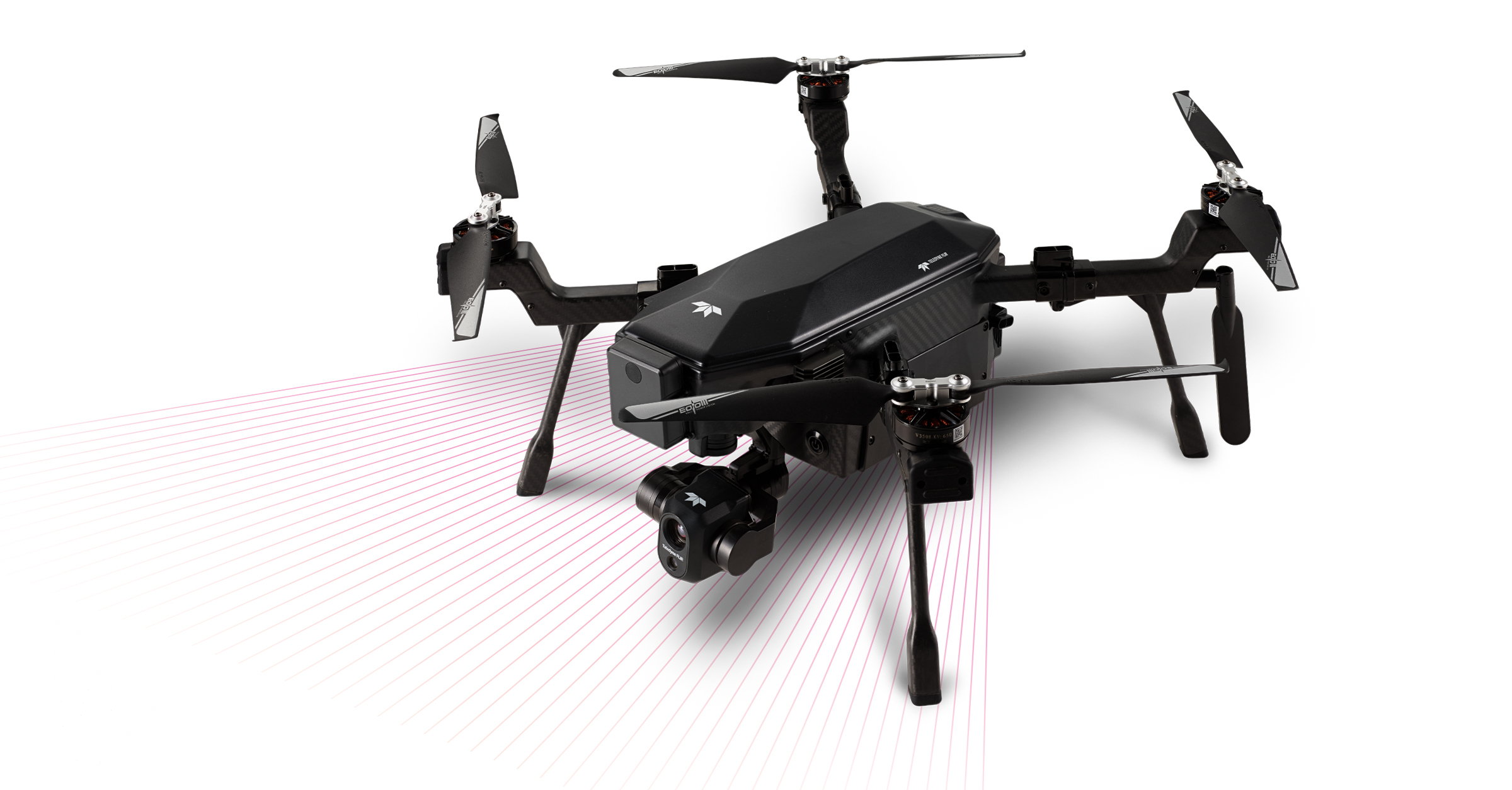FAQ - Everything You Need to Know About SIRAS
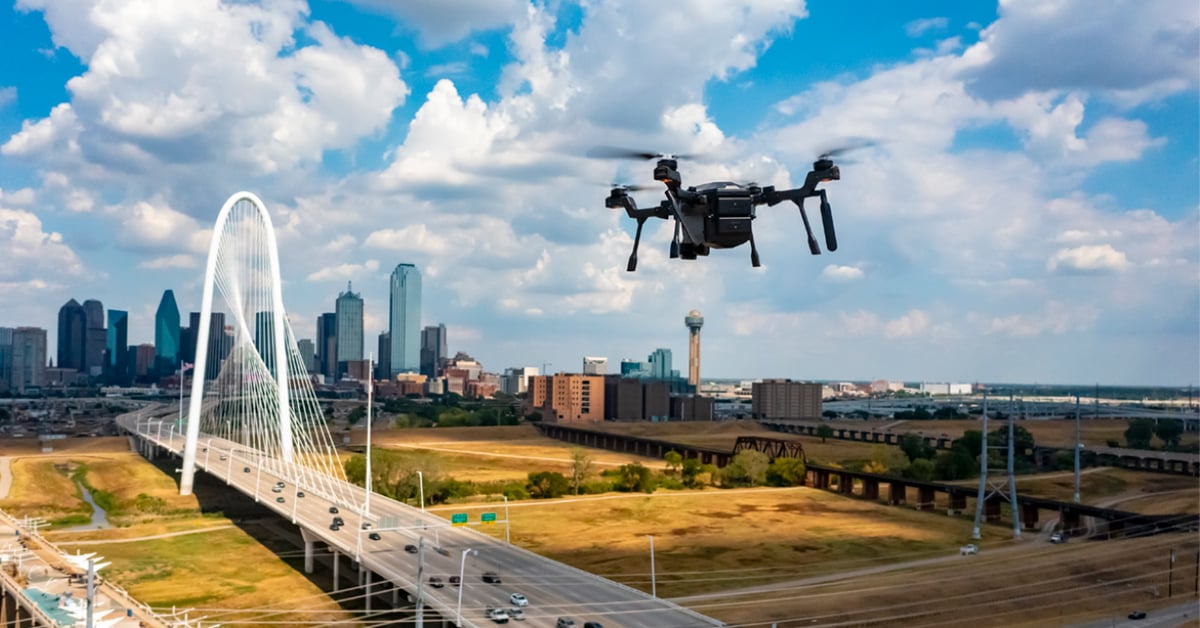
The following frequently asked questions will be updated without notification as we expand features and capabilities. Please let us know if you have any additional questions. We are happy to help you.
TABLE OF CONTENTS
-
General
-
Payloads
-
Performance
-
CONTROLLER
-
SOFTWARE (FLIGHT APP) & FIRMWARE
-
OBSTACLE AVOIDANCE
-
DATA SECURITY
-
NDAA/BLUE COMPLIANCE
-
EXPORT
-
MANUFACTURING
-
PURCHASING AVAILABILITY
-
SUPPORT
-
WANT TO LEARN MORE?
GENERAL
Q: What is SIRAS?
A: The Teledyne FLIR SIRAS is an affordable professional drone with a swappable quick-connect payload system. It ships with a gimbaled dual camera Vue® TV payload that includes a high-resolution radiometric thermal (FLIR Boson®) and a high-resolution visible camera payload for industrial inspection, law enforcement, firefighting, search and rescue, and mapping missions.
Q: What does SIRAS offer that its competitors don’t?
A: High-performance thermal and visible light imaging, data security, no geo-fencing, and a professional drone at an affordable price. SIRAS is an affordable professional drone that includes both thermal and visible-light sensors.
SIRAS is built for improved data security – it does not include Bluetooth, Wi-Fi, or cellular capability, so all your imagery and flight data stays on board until you take it off.
With a startup time of two minutes, hot-swappable batteries, radar-based front collision avoidance, up to 31-minute flight time (not hovering, no wind, and set in position mode), and no geofencing mean UAV pilots can fly efficiently and safely when and where the mission demands.
SIRAS provides best-in-class imagery, mission flexibility, data security, plus compatibility with leading photogrammetry software, enabling the pros to get the job done.
Q: How is SIRAS more versatile than its competitors?
A: SIRAS provides a geofence-free flight experience and a quick-connect gimbal, so future payloads with additional features can be swapped for specialized missions. The existing SIRAS dual sensor payload includes a visible 16MP camera with up to 128x zoom to pinpoint details. In comparison to the leading drone maker, at max zoom, the EO sensor provides up to 30 percent more pixels on target.
The companion 640x512 pixel high resolution FLIR Boson infrared thermal camera provides clear imagery, 5x digital zoom, and temperature-measuring capabilities.
Q: What is the competition for SIRAS?
A: Today, China-based companies dominate the global commercial drone market but are increasingly under pressure concerning privacy and data security issues. Domestic drone manufacturers struggle with volume production and significantly higher pricing than Chinese competitors. SIRAS provides the data security and features customers in North America require but at a price point more aligned with China-based drone makers.
Q: Why will customers choose SIRAS over foreign competitors?
A: SIRAS offers comparable flight performance and superior imagery to the leading drone brands but at a price point significantly lower than the domestic competition, yet it offers payload flexibility and data security peace-of-mind that buyers require. Furthermore, customers enjoy data security and USA-based customer service and support, all from a trusted USA-based organization.
Q: How and where does SIRAS store data and images?
A: SIRAS is designed for security. It does not connect to the internet, local Wi-Fi networks, or cellular networks. This is to prevent pathways that may enable third parties to view or upload your data and images. All data is stored in high resolution on the aircraft SD card. Low resolution data can be stored on the controller SD card.
Q: If there is no network connection, how are firmware updates executed?
A: Updates are available on the Teledyne FLIR SIRAS support site for download onto an SD card. Updates are uploaded from the SD card to SIRAS. For detailed steps on updating your drone firmware, please refer to the SIRAS User Manual.
Q: How do I navigate to the location where the installed firmware is indicated?
A: On the SIRAS controller, open Settings, About, and scroll down to check the firmware versions.
Q: Does SIRAS have collision avoidance?
A: Yes, SIRAS has a forward-facing radar system that is activated automatically when the return to home (RTH) feature is engaged or when manually turned on by the pilot. The system will detect objects out to approximately 100 feet when flying at 13 mph or less. There is no side or top collision avoidance feature. However, SIRAS has bottom-mounted sensors to detect the ground when descending and landing.
Q: What kind of Flight Controller does the SIRAS have?
A: SIRAS was built from the ground up from proprietary components and that includes the flight controller.
Q: How does the drone fold or store?
A: The legs have clips that slide to allow them to be folded in for compact storage.
Q: How do I store the SIRAS batteries?
A: Store them in a cool, dry environment. WARNING – Do not store SIRAS batteries in an unplugged charger or in the aircraft when not in use – this will slowly drain the batteries and/or cause irreversible damage.
Q: What accessories are available or are planned for SIRAS? Where do I buy them?
A: A hard storage case, a tactical soft pack storage case, and an 8-cell battery charger are under development for release in 2024. Spare parts, especially props and batteries, are available now from your dealer.
Q: The SIRAS is advertised as having a hot-swappable dual-battery configuration. Some other drones with similar features are built to be capable of limited flight to return home in the event of a single battery failure. Does the SIRAS have this capability?
A: The hot swap allows the airframe to stay on while changing batteries which eliminates the need to boot up the system again. SIRAS can fly on one battery in an emergency situation. This is highly discouraged because one battery may discharge beyond its design intention leading to permanent damage to the battery.
Q: How sensitive are the batteries to heat?
A: The suggested operating temperature is 14 ⁰F to 104 ⁰F (−10 ⁰C to 40 ⁰C). Be sure not to recharge the batteries until they have cooled to near room temperature. The battery charger will display an error message if the battery temperature is too high.
Q: Why should I register my siras?
A: Registration allows Teledyne FLIR to quickly contact you to provide firmware updates and other important information. Teledyne FLIR will not share your registration information.
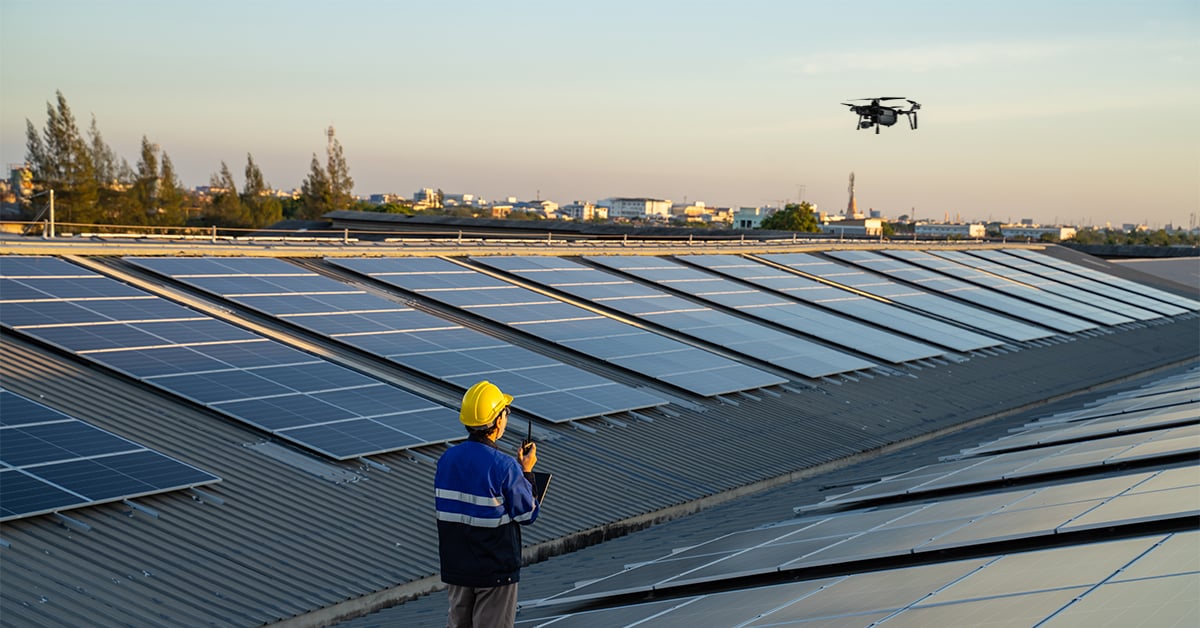
PAYLOADS
Q: Can you tell me about the payload on SIRAS?
A: The quick-connect Vue® TV128 payload features a visible 16MP resolution camera that zooms up to 128x to pinpoint details, offering 30 percent more pixels on target at max zoom in comparison to the leading China-based brand. A companion 640x512-pixel, radiometric FLIR Boson provides sharp thermal imagery, 5x digital zoom, and accurate temperature-measurement.
Furthermore, the radiometric infrared sensor has additional analytical features including a spot meter, area measurement tool (where hottest, coolest, and average temps within the region are displayed), and isotherms. The pilot can also select their preferred color palette, such as white hot, black hot, or iron bow, among others.
Q: How does the dual sensor payload system work? Can you do side-by-side and/or one or the other?
A: The SIRAS Controller can display either the IR video stream or the EO video stream.
Q: Do you have plans for additional payloads? If so, what is coming?
A: We do indeed plan to release additional payloads and are working on the next two as we speak. These will be specific to certain market verticals to improve the utility of SIRAS for a variety of applications, including additional application-specific software features to support the respective intended missions.
Q: When do you plan to release new payload(s)?
A: We are working on them now and are excited to discuss them when they are validated and ready for sale.
Q: What is the zoom factor for the visible and thermal cameras?
A: Vue TV128 payload visible camera zoom is 128x while the thermal camera zoom is 5x.
Q: Does the thermal camera have various color palettes and if so which ones?
A: Yes. Those pallets are white hot, black hot, iron bow, and others.
Q: What is the difference between 336 × 256 and 640 × 512 resolution cameras?
A: Each FLIR UAS thermal camera has an imaging detector which converts the heat energy it receives into a video image. These detectors come in 336 × 256, and 640 × 512 resolution options. The first value represents the horizontal pixel count and the second number represents the vertical pixel count. At a quick glance, many people assume the 640 is twice the resolution at a 336 but in fact, the total pixel count is 3.8x more. 336 × 256 delivers 86,016 total pixels and 640 × 512 delivers 327,680 pixels. The more pixels a camera has, the higher its resolution and the better its image quality (all things being equal).
Q: What is the field of view?
A: Field of view, also referred to as FOV, is the angular measurement of the view the camera provides. Think of it as the size of the window you’re looking through. For example, each pixel in the 640 × 512, 13 mm configuration (45° × 37° FOV) will represent an angle of 0.07 degrees per pixel, meaning that at 100 feet, each pixel is imaging 1.57 inches. From a less technical perspective, FOV equates to the observable area that can be imaged with the lens.
The Vue TV128 has a thermal horizontal FOV of 32° and a visible camera horizontal FOV of 67°.
Q: Does the RGB camera usE a mechanical shutter?
A: No, it does not use a mechanical shutter.
Q: What is the thermal camera’s sensitivity?
A: The Boson sensitivity is <50 mK.
Q: What is the thermal camera’s accuracy?
A: Assuming all thermographic corrections are made accurately (e.g., emissivity and reflected apparent temperature) the thermal camera’s temperature readings will be accurate to +/-5°C when measuring temperatures between 0°C - 100°C (+/-9°F for temperatures between 32°F - 212°F).
Q: Are you developing a tethering system for this unit?
A:There is no tethering compatibility at the time of this response, however this is being taken into consideration along with other advancements of the SIRAS ecosystem and offering.
Q: Will SIRAS have an agricultural sensor?
A: The Vue TV128 payload is the only payload that has been released for SIRAS. There will be more on offer in the future, and through your feedback you can assist us in determining what we develop.
Q: Is there going to be a non-thermal option? If so, is it cheaper than the current version shown?
A: There is high demand for different specifications of a visible payload for mapping purposes. Although not determined, this is very likely and would expand the capabilities of existing SIRAS owners or be purchased at a different package price than the current bundle with the Vue TV128 payload.
Q: Will an upgrade for SIRAS to have a gas analyzer integrated to it aside from thermal images?
A: Teledyne FLIR sits on a plethora of technologies relevant to UAS operations. We will be exploring which technologies can be leveraged by SIRAS and developing around the feasibility and customer feedback.
Q: Why does the thermal camera freeze periodically for a second?
IR cameras perform a NUC (Non-Uniform Correction) prior to adjusting level and span. This automatically corrects the minor detector drift that occurs as the scene and environment changes. The camera will also perform this operation on its own from time to time. Think of this as setting all the pixels back to a base reference point.
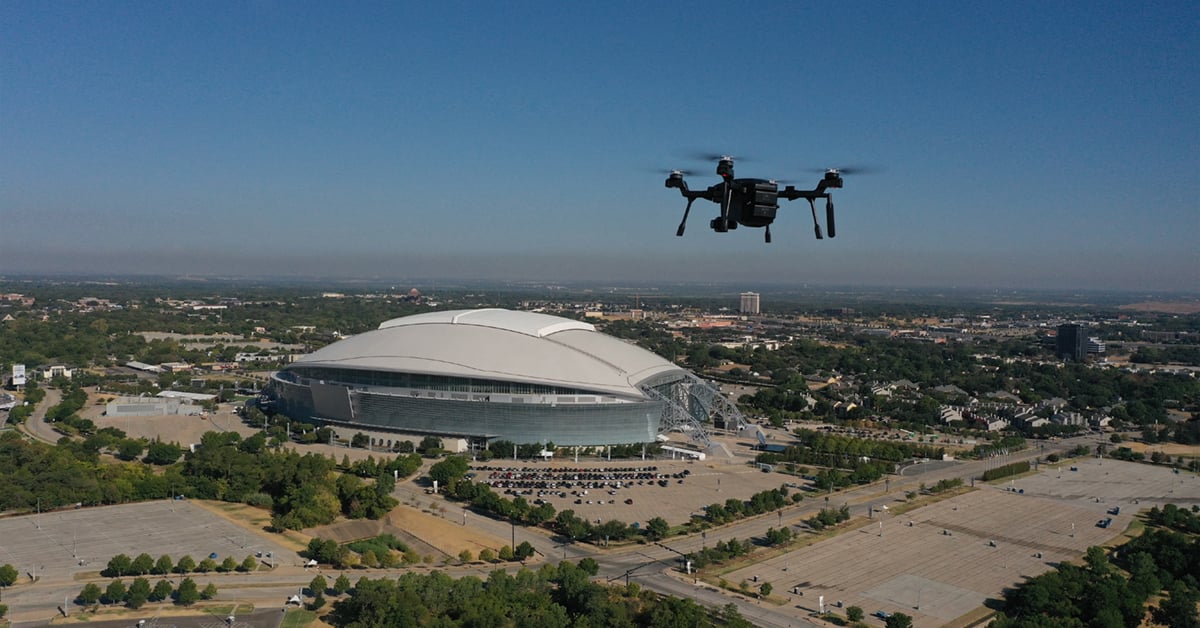
PERFORMANCE
Q: How can I start SIRAS?
A: Slowly move sticks down and in, toward you and together. Hold the sticks in this position for up to three seconds or until the motors start.
Q: Can I fly more than one SIRAS at a time?
A: Yes, pilots need to be at least 20 feet (6 meters) apart from each other to minimize the potential for radio interference.
Q: What is the flight time for SIRAS?
A: The maximum flight time for SIRAS is 31 minutes. This is based on ideal flying conditions (no wind, fresh batteries, optimal ground speed). In general, SIRAS will fly for 25 minutes under typical flying conditions, taking the batteries down to 10 percent.
Q: What is the maximum ground speed for SIRAS?
In Sport Mode, SIRAS will achieve 40 mph ground speed in windless conditions. Maximum speed in Position Mode is 13 mph.
Q: When hovering what level of wind can SIRAS resist and maintain position against?
A: 22 mph (Beaufort Scale 5).
Q: Does SIRAS have various flight modes?
A: Yes, SIRAS has Attitude, Position, and Sport Modes. Pilots can change between these modes in flight using the switch on the controller.
Q: How long does it take from turn on to flight?
A: SIRAS will turn on, connect to GPS satellites, and be ready to fly in about two minutes.
Q: How long does it take to charge the SIRAS batteries?
A: Approximately 45 minutes
Q: Are the batteries hot swappable?
A: Yes.
Q: How low can you drain the batteries without damaging them?
A: Do not drain the batteries below 5%, ideally not below 10%, to maximize their lifetime.
Q: Is there a multi-cell (more than two) SIRAS battery charger?
A: An 8-cell (4-battery pairs) charger is planned for release in 2024.
Q: What are the operating frequencies of the SIRAS controller?
A: 2.4 GHz and 5.8 GHz, dual band.
Q: What is the transmission range of the SIRAS controller?
A: The maximum range under ideal conditions (no obstructions, no radio interference) is six miles. However, ideal conditions are usually only found over water or in wide-open, flat, rural landscapes. Pilots are urged to use good judgement when flying beyond visual line of site as interference and/or obstructions (hills, buildings) can cause loss of contact between SIRAS and its controller. When signal is lost SIRAS will activate its return to home (RTH) feature including its collision avoidance and return to its take off point in Position Mode (13 mph). If flying BVLOS, make sure the remaining battery levels are sufficient to achieve RTH under these conditions.
Q: Why does this only have an 11.1 mph wind resistance?
A: This is a typo error on early release specifications. The Wind resistance is 22.2 mph. We are currently testing higher wind conditions so we may revise this spec upward in the future.
Q: How well does this drone perform in the high-RF environments of electrical utility inspection?
A: All such environments are different, but in use to date, once calibrated the drone performs well in these environments. It is recommended to keep the drone close to the controller (within 300 yards) and pay attention to any magnetic interference warnings that are communicated on the controller.
Q: What's the max speed for thermal mapping compared to a drone with the Zenmuse XT2? Would it still be the ~5m/s?
This is more of a matter of best practices versus the capabilities of the hardware. The XT2 and Vue TV128 are both 640x512 thermal imagers. The capture speed would be the same as they are capturing similar imagery from your set height above target.
Q: How to Fix Gimbal Drift?
The following steps can be used to troubleshoot gimbal drift:
- Power on SIRAS and GCS.
- Start the Go Fly application.
- Tap the three dots in the upper right corner of the GCS screen.
- Select Control.
- Scroll to and select Gimbal Calibration.
- A pop-up message will let you know when calibration is complete.
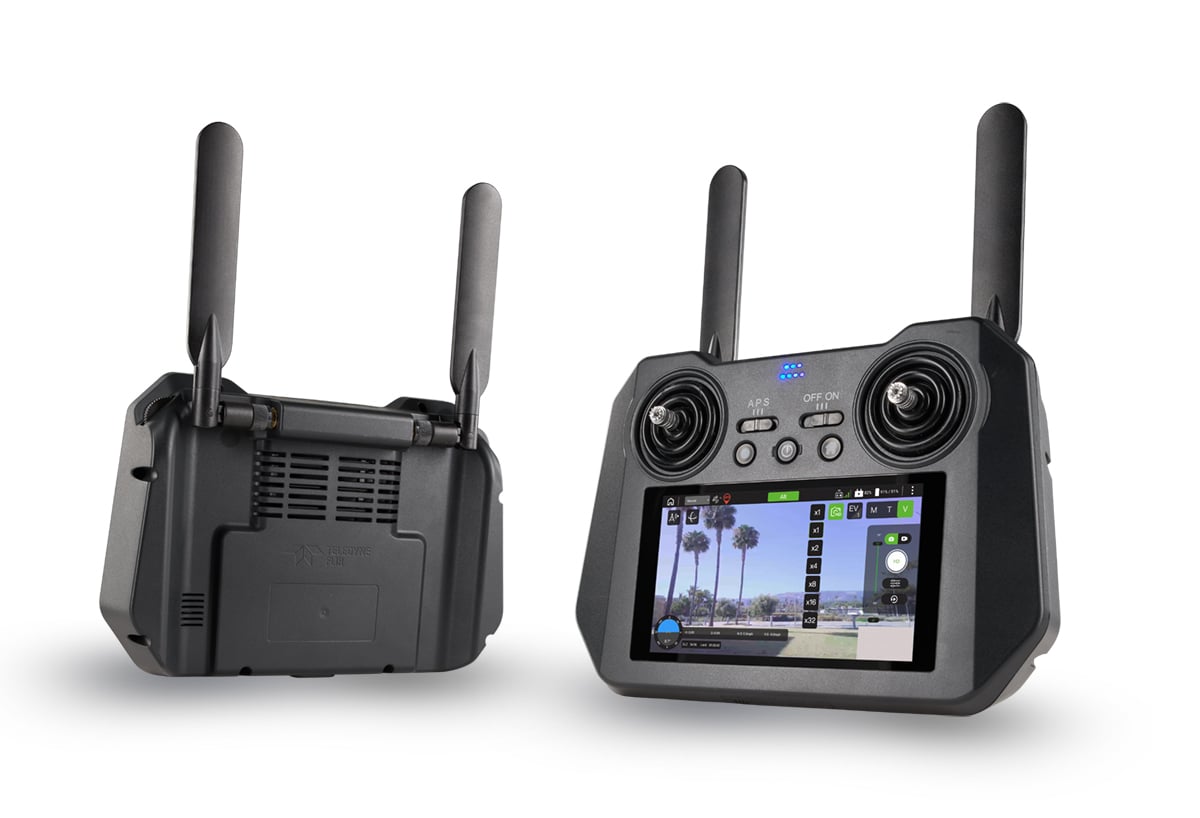
CONTROLLER
Q: What is the default controller stick layout?
A: Mode 2
Q: How long does the controller battery charge last?
A: Approximately 90 minutes
Q: Can video and imagery from the controller be fed to external monitors?
A: Yes, the SIRAS controller is equipped with an HDMI output port.
Q: What size is the controller screen?
A: The built-in screen is 2.5 by 4.5 inches somewhat bigger than a typical mobile device. It is not changeable outside of HDMI out into another monitor.
Q: Is there a mechanism for live streaming video from the drone to a command post or multiple interested stakeholders?
A: Other than the HDMI out from the controller, there is not a hardware component to extend the streaming video to other monitors. There are third-party components that may enable this but are currently undefined by Teledyne FLIR. Since the product does not connect to the internet there is not a digital method to do this.
SOFTWARE & FIRMWARE
Q: What software does SIRAS use for in-flight management?
A: The SIRAS controller includes the Go Fly application that allows pilots to manually fly, plan missions, map missions, and control the aircraft payload. The imagery is compatible with industry-leading photogrammetry software.
Q: Is there an Application Programming Interface (API) available for custom, third-party application development?
A: An API is on the development plan with an anticipated release date in late 2023. Please complete the RFI form at www.flir.com/siras and note “Request SIRAS API” in the “Comments” section to receive the API launch notification.
Q: What options are there for post-flight data processing and analysis?
A: SIRAS records images and video in formats compatible with most post flight software: MP4, Tiff files, and radiometric jpegs. For post-processing analysis, Teledyne FLIR data is compatible with leading photogrammetry tools on the market today.
Q: Is SIRAS Remote ID compliant?
A: Yes, SIRAS is Remote ID compliant. The FAA has accepted SIRAS’s declaration of compliance for Remote ID. Pilots don’t need to do anything to enable Remote ID on SIRAS.
Q: Does SIRAS utilize AI-based automation tools to improve inspection accuracy and efficiency?
A: Not currently, but Teledyne FLIR is always exploring new software capabilities to integrate into the SIRAS platform, and we will keep you updated as new features and tools are introduced.
Q: Is there a mapping mode?
A: Yes.
Q: Is there a mission planning and flight mode?
A: Yes.
Q: Will you be allowing DroneSense access so it can run on DroneSense?
A: There will likely be significant expansion into third-party software as the product is released. There is no determination of which collaborations will move forward, but we are paying attention to the feedback we receive which is most important to their workflows.
Q: Is FLIR seeking integration with RaptorMaps and other PV inspection analysis services?
A: There will likely be significant expansion into third party software as the product is released. They have not been finalized, but what the market finds valuable will be a top the priority list for third-party integration.
Q: Is there any autonomous software built in i.e., gridded photo capture missions or gridded manual-photo flights or at least waypoint flights or keyframe flights?
A: The SIRAS flight app includes mission planning for photogrammetric purposes. These capabilities will likely expand as the product matures.
Q: Will there be support for any software updates or new features included in the purchase price?
A: SIRAS will continue to advance and expand beyond the time you purchase. There will be available firmware upgrades as well as new hardware components and app compatibility that will not require you to spend more with Teledyne FLIR to enable. Keeping SIRAS updated with the latest firmware will improve flight stability, navigation, and user experience.
Q: Can you pin locations while flying?
A: No, there is not currently a point-of-interest marking function currently built into SIRAS.
Q: How do I know I have the latest firmware?
A: Routinely check www.flir.com/sirassupport to be sure you have the current firmware.
Q: How do I get the latest firmware?
A: Download firmware at www.flir.com/sirassupport
OBSTACLE AVOIDANCE
Q: Will or does it have all direction obstacle avoidance?
A: SIRAS has front facing radar to avoid objects in front of the aircraft and an array of sensors on the underside of the aircraft for detecting the ground. It does not have sensors above, behind, or to the sides of the aircraft.
Q: What is the reach of the front radar?
A: 100 feet using a cone projected forward with a 38⁰ FOV. The aircraft must fly at 5 m/sec (13 mph) or less to assure maximum effectiveness in detecting objects. It comes on automatically during the return to home function. Its default setting is off, but it is easily activated by pressing an icon on the controller display. It works in both day and night situations.
Q: Can the front facing radar be turned off? Will the radar be inhibited by smoke, or prevent the UAS from moving through smoke?
A: Yes, the radar can be turned off entirely or only enabled for return-to-home failsafe purposes. Radar was selected because unlike the usual visible light sensors used for avoidance, it is not inhibited by darkness, smoke, or fog.
DATA SECURITY
Q: How is the SIRAS data secured? What certifications does it possess?
The aircraft has no transmission capability other than between the airframe and the control console. It does not provide cellular transmission, Wi-Fi, or Bluetooth capabilities (other than to comply with remote ID).
In total, SIRAS Certifications include CE mark, FCC certification, RoHS & REACH compliance, including being FAA remote ID capable.
Q: SIRAS is not subject to geo-fencing. Why does that matter?
A: Control of SIRAS is in the hands of the pilot. Public safety personnel especially need to launch quickly and get the mission completed wherever they are, as lives and property are often on the line. They cannot wait to get permission from an entity in a foreign country to fly where and when they need to. SIRAS enables pilots to launch within two minutes of power up, no questions asked, but it is the responsibility of the pilot to know where and when it is safe to fly. SIRAS is for professional, certificated remote pilots who know the rules and need to get in the air fast.
Q: Does the controller connect to the internet?
A: No, for data security reasons SIRAS has been designed to never connect to the internet.
Q: Other producers use RTK antennas to deal with interference, what about SIRAS?
A: SIRAS does not have RTK antennas as these generally require an internet connection and SIRAS was specifically designed to have no internet connection for data security purposes.
NDAA/BLUE COMPLIANCE
Q: Is SIRAS part of the Defense Innovation Unit’s Blue sUAS program?
A: No.
Q: Is the SIRAS NDAA-compliant and pre-approved for government acquisition?
A: No. SIRAS is intended for commercial missions, industrial missions, and local public safety. At this time NDAA compliance is not a requirement for this product, but we are always evaluating and open to exploring this option in the future.
EXPORT
Q: Can SIRAS be exported to other countries?
A: SIRAS is available in the US with additional regional availability information provided at www.teledyneflir.com/siras. SIRAS is dual use and classified under US Department of Commerce jurisdiction as EAR 6A003.b.4.b.
Q: Can SIRAS be used in all parts of the world?
A: SIRAS is being released in the United States in Fall 2022. Please see www.flir.com/siras for availability in other regions.
MANUFACTURING
Q: Where is the SIRAS manufactured?
A: The aircraft is manufactured in Taipei, Taiwan from components sourced principally in Taiwan. The payload is manufactured at the Teledyne FLIR facility in Goleta, Calf., USA. Repairs and primary customer service are also performed in the USA by Enterprise UAS.
Q: The body of the drone in ABS or is it a composite material?
A: The aircraft is a combination of ABS plastic (certain components) and carbon fiber components.
PURCHASING/AVAILABILITY
Q: How do I buy SIRAS?
A: SIRAS is sold through a distribution network. Please see www.TeledyneFLIR.com/SIRAS for more information. Enterprise UAS is the exclusive master distributor.
Q: What is the price, and are there different versions with different price points?
A: The Teledyne FLIR SIRAS Standard Bundle has an MSRP of $9,695.00 USD. The standard bundle includes the SIRAS airframe, the Vue TV128 payload, two batteries, a battery charger, propellers, a controller, a charging cable, and a backpack carrying case. Visit www.TeledyneFLIR.com/SIRAS for more details.
Q: Will there be support for any software updates or new features included in the purchase price?
A: SIRAS will continue to advance and expand beyond the time you purchase. There will be available firmware upgrades as well as new hardware components and app compatibility that will not require you to spend more with Teledyne FLIR to enable.
Q: When should we expect demo units to be delivered?
A: If you are interested in demonstration of the SIRAS, please reach out to [email protected].
Q: Is SIRAS available outside the USA?
A: SIRAS has all certifications necessary to be sold into the United States. However, many countries have their own rules for certification of radio and battery technologies. We are working with select partners abroad on achieving certification, and if you are interested to discuss this reach out to [email protected].
SUPPORT
Q: What kinds of customer support are you offering?
A: Customer support and repair will be handled through the distribution network, primarily Enterprise UAS which will provide service and repair.
WANT TO LEARN MORE?
Catch OUR WEBINAR REPLAYS below.

